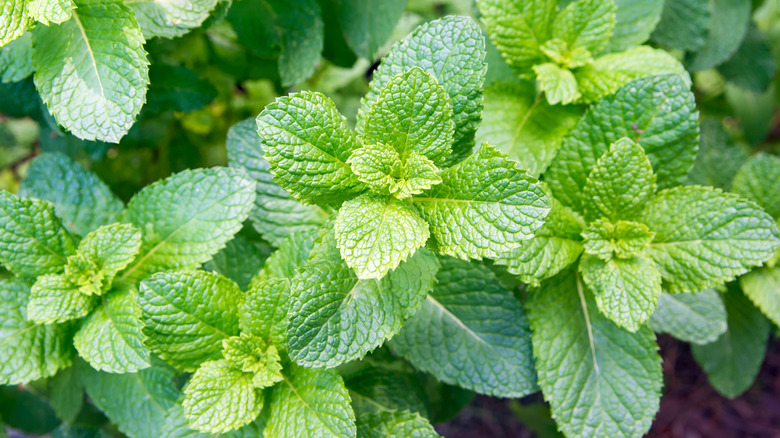Peppermint Candy's Roots Trace Back To Herbal Healing
We may receive a commission on purchases made from links.
From toothpaste to no-bake chocolate peppermint cheesecake, the peppermint herb sits firmly at the intersection of dessert and medicine. It's a unique identity, simultaneously sweet and utilitarian, maintaining fairly equal citizenship in both nations. Today, peppermint candies still boast impressive health benefits. Yet long before they entered the confectionery sphere in hard-candy form, peppermint leaves were prized by ancient physicians not for their taste but for their potent medicinal properties.
The earliest record of peppermint's prominent role in ancient medicine begins with the Egyptian civilization of 1000 B.C. The Ebers Papyrus names mint as a known digestive in 1550 B.C., and dried peppermint leaves have been discovered inside pyramids dating back at least 3,000 years. Mentions of mint as a venerated herb even appear scrawled on the walls of the temple of Horus in Edfu, as well as in the Christian Bible and Babylonian Talmud.
Peppermint is a Mediterranean herb indigenous to Europe and Asia. In Classical Antiquity, ancient Greeks and Romans were using aromatic peppermint leaves in funerary rites, and Pliny the Elder prized peppermint as a headache remedy. Byzantine physicians of the Middle Ages expounded on Pliny the Elder's medicinal findings, expanding the knowledge of peppermint as a therapeutic tool. During the American Civil War, army hospitals on both sides stocked peppermint oil, tincture, or fresh spearmint. So, when did this fragrant, ancient herb finally see its candied rebrand?
Peppermint cough drops bridged the gap between medicine and candy
On a scientific level, peppermint's active ingredient is menthol, which naturally stimulates cooling receptors in the mouth and nose. The effect is refreshing, invigorating, eases tissue inflammation, relieves pain and burns as a topical wound treatment, reduces muscle spasms and contractions, relieves dental pain, and treats bacterial overgrowth. Ayurvedic medicine prizes peppermint as a stimulant that also helps clear the mind.
It was with another symptom — sore throat — that peppermint found its initial breakthrough into the candy sphere. Enter cough drops. By the 1800s, confectioners were cutting peppermint with sugar to make flavorful, accessible, appealing lozenges and candies. Many of these early hard candies combined that menthol with honey and eucalyptus, which reads more like the ingredients list for a medicinal tincture than for a sweet treat. Peppermint cough drops delivered the cooling sensation, inflammation reduction, and localized numbing effect that folks needed, as well as the flavor they craved.
In the 1850s, Poughkeepsie-based brand Smith Brothers was one of the first companies to put cough drops on the map. Pioneers William and Andrew Smith even obtained a trademark for their cough drops in 1877, one of the first official registered trademarks in American history. The mid-1800s also saw technological advancements in industrial-scale candy-making. By the early 1900s, Smith Brothers cough drops had established a factory that could crank out a whopping 6 tons of cough drops every single day.
Peppermint candies, teas, and desserts remain both tasty and healthy
After the rise of Smith Brothers' cherry-tasting cough drops, public preference began to shift toward peppermint foods that tasted more like candy than medicine. Thus marked peppermint's gradual voyage from the medicinal to the confectionery sphere. To quote an article in American Heritage Magazine (via Hudson Valley Magazine): "There, on the banks of the Hudson River, two canny Scots made the throat lozenge an American institution." Where Smith Brothers championed a cherry throat drop, competitor brand and enduring giant HALLS hit the market in the 1930s with a peppermint-centric menthol and eucalyptus flavor. Globally, peppermint-flavored foods like peppermint tea remain regarded as a sleep aid (Rishi peppermint loose leaf is our all-time favorite brand, for the record). After-dinner mints became popular in the 1960s for peppermint's digestive qualities, and chewing gum is customarily peppermint flavored.
Fittingly, peppermint's emergence as winter's signature taste also reflects the intersection of everyday utility and dessert appeal. The seasonal connection to peppermint-frosted sugar cookies, peppermint hot cocoa, and peppermint chip ice cream apparently traces back to Cologne, Germany in 1670. Per the lore, a choirmaster commissioned suckable candy sticks from a local confectioner as a method for keeping restless kiddos quiet and satiated during lengthy church holiday services in the winter season. By the 1800s, those sticks were peppermint-flavored and red-striped, and peppermint candy was here to stay.


